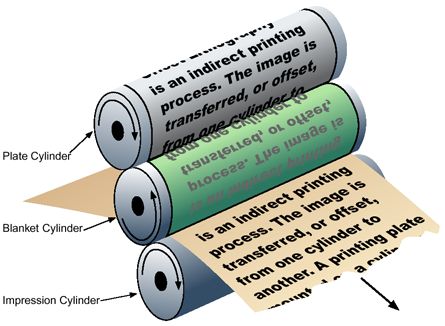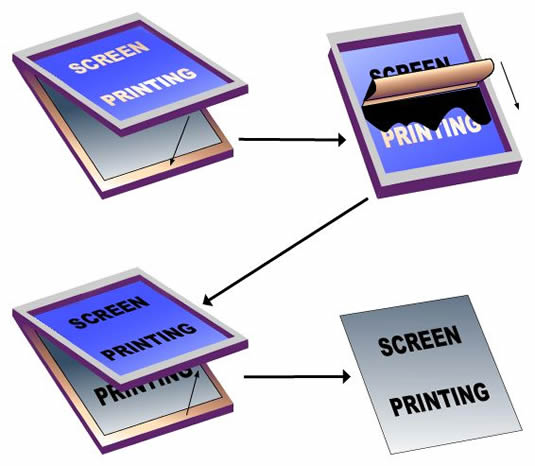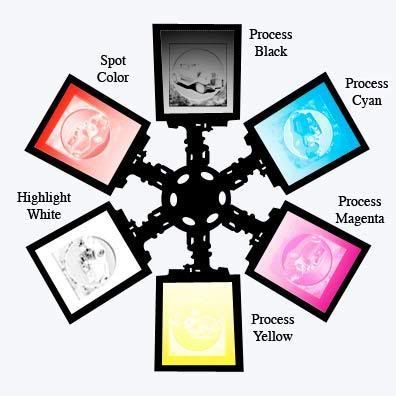Lithography
Lithography refers to a lithograph print that is made from an image which has been applied to a flat surface. Traditionally this flat surface was a specially prepared lime stone, but today grained aluminium-printing plates and the original stones are used. The process is based on the fact that oil repels water. An image is drawn, painted or photographically applied the stone or plate using a greasy medium. The image will repel water and accept ink. Lithographic inks are oil based.
Screen Printing
Screen printing was a technique first used by the Chinese almost 2000 years ago. They used human hair stretched across a wooden frame to form the screen. To that they attached a stencil made from leaves stuck together into different shapes. This was probably the first application of screen printing ever.
Screen printing is one of the early methods of printing. It involves the passing of ink or any other printing medium through a mesh or 'screen' that has been stretched on a frame, and to which a stencil has been applied. The stencil openings determine the image that will thus be imprinted.
Gravure
Gravure is an intaglio printing process. The image carrier has the image cut or etched below the surface of the non-image area. On the gravure image carrier (usually a copper cylinder), all the images are screened, creating thousands of tiny cells.
During printing, the image carrier is immersed in fluid ink. As the image carrier rotates, ink fills the tiny cells and covers the surface of the cylinder. The surface of the cylinder is wiped with a doctor blade, leaving the non-image area clean while the ink remains in the recessed cells.
Digital printing
Digital printing refers to methods of printing from a digital-based image directly to a variety of media.
The greatest difference between digital printing and traditional methods such as lithography, flexography, gravure, or letterpress is that there is no need to replace printing plates in digital printing, whereas in analog printing the plates are repeatedly replaced. This results in quicker turnaround time and lower cost when using digital printing, but typically a loss of some fine-image detail by most commercial digital printing processes. The most popular methods include inkjet or laser printers that deposit pigment or toner onto a wide variety of substrates including paper, photo paper, canvas, glass, metal, marble, and other substances.
Laser Printing
Laser printing is an electrostatic digital printing process that rapidly produces high quality text and graphics by passing a laser beam over a charged drum to define a differentially charged image. The drum then selectively collects charged toner and transfers the image to paper, which is then heated to permanently fix the image. As with digital photocopiers and multifunction printers (MFPs), laser printers employ a xerographic printing process, but differ from analog photocopiers in that the image is produced by the direct scanning of the medium across the printer's photoreceptor. Hence, it proves to be a much faster process compared to the latter.
Flexography
Flexography is the major process used to print packaging materials. Flexography is used to print corrugated containers, folding cartons, multiwall sacks, paper sacks, plastic bags, milk and beverage cartons, disposable cups and containers, labels, adhesive tapes, envelopes, newspapers, and wrappers (candy and food).
Silkscreen printing
You can do this at Blenheim, the screens are a different colour to the paper screens.
Silk screening is a process which is used to create prints on a wide variety of materials, from fabric to wood. Many commercial printers use silk screening to print, since it is cheap and easy, and when done well, it results in high quality prints. Home crafters and fine artists also use the silk screening technique for projects, and it is relatively easy to learn.
Halftone
halftone process, in printing, a technique of breaking up an image into a series of dots so as to reproduce the full tone range of a photograph or tone art work. Breaking up is usually done by a screeninserted over the plate being exposed. The screens are made with a varying number of lines per inch, depending on the application; for newspapers, the range is 50 to 85, and for magazines, 100 to 120. The highest quality reproduction requires 120 to 150 lines per inch.
Just as color photography evolved with the addition of filters and film layers, color printing is made possible by repeating the halftone process for each subtractive color—most commonly using what is called the "CMYK color model".The semi-opaque property of ink allows halftone dots of different colors to create another optical effect—full-color imagery.
Monoprinting
Monoprinting is a form of printmaking in which images or lines are made that cannot exactly be reproduced. There are several techniques of mono-printing, including hand-painted additions, collage and a form of tracing whereby the thick ink is laid down on a table, paper is placed on its top and is then drawn on.
Mono printing uses printing materials but only produces one image. There are two techniques.
Technique one
- place glass on top of an image
- trace the image onto the glass using paint
- lay paper over the surface and smooth the back with a roller
- peel off the paper to reveal your image
Explore the different thicknesses of ink and try scratching into the ink.
Technique two
- roll out a layer of thin ink onto a surface and then place paper over the top
- draw onto the back of the paper
- peel off the paper
Offset printing
It is called offset because of the process on how inks are transferred to print an image. The ink is not directly pressed onto the paper; it uses plate cylinder where the image comes. From a metal plate, ink is distributed to an offset cylinder (rubber mat) before it is transferred directly onto the paper through an impression cylinder.
The process is done because the water and ink do not mix. The image is set on a printing plate. It is dampened by oil-based ink and water using rollers on the printing machine. The created image is transferred to the cylinder and then to the paper.
There are four colors used when printing on paper sheets or cardstocks. The color of cyan, magenta, yellow, and black are mixed to form a final product with good color resolution.
The process is done because the water and ink do not mix. The image is set on a printing plate. It is dampened by oil-based ink and water using rollers on the printing machine. The created image is transferred to the cylinder and then to the paper.
There are four colors used when printing on paper sheets or cardstocks. The color of cyan, magenta, yellow, and black are mixed to form a final product with good color resolution.
Spot colour printing
Refers to a method of specifying and printing colors in which each color is printed with its own ink. In contrast, process color printing uses four inks (cyan, magenta, yellow, and black) to produce all other colors. Spot color printing is effective when the printed matter contains only one to three different colors, but it becomes prohibitively expensive for more colors.










No comments:
Post a Comment